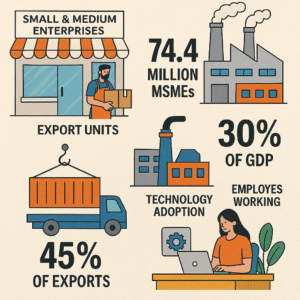
Trump’s 25% Tariffs on India: Impact on Sensex, Nifty 50 & India‑US Trade Tensions

Former US President Donald Trump has announced a 25% tariff on Indian imports, effective August 1, citing India’s trade policies and ties with Russia. This high-stakes move is already rattling Indian equities, pressuring the Sensex and Nifty 50, and posing risks for exporters across key sectors.
Table of Contents
Published: July 31, 2025
Last Updated: July 31, 2025
Reading Time: 18 minutes
Introduction: Understanding the U.S.-India Trade Tension
On July 30, 2025, the United States announced significant changes to its trade relationship with India. President Donald Trump declared a 25% tariff on Indian imports, scheduled to take effect on August 1, 2025. This policy shift represents one of the most substantial adjustments in bilateral economic relations between the two nations in recent decades.
The announcement affects multiple sectors of the Indian economy and has generated immediate responses in financial markets. This development occurs within the broader context of the Trump administration’s revised approach to international trade policy. Understanding the full scope of these measures requires examining their structure, rationale, and potential consequences for both nations.
This analysis provides a detailed examination of the tariff announcement, market reactions, sectoral impacts, and the diplomatic considerations surrounding this economic policy shift. The information presented draws from official government statements, market data, and verified institutional sources.
The Tariff Announcement: Structure and Details
Primary Measures Implemented
The tariff structure announced by President Trump contains several distinct components. The primary measure establishes a flat 25% duty on all goods imported from India into the United States. This uniform rate applies across product categories without initial exemptions for specific industries or commodities.
The implementation date of August 1, 2025, provides minimal adjustment period for businesses engaged in India-U.S. trade. The comprehensive coverage extends to manufactured goods, agricultural products, and industrial materials. This broad application distinguishes the measure from targeted tariffs that typically focus on specific sectors.
Additional Penalty Framework
Beyond the base 25% tariff, the announcement references supplementary penalties linked to India’s international partnerships. These additional measures specifically target India’s energy procurement practices and defense equipment acquisitions. The administration has expressed particular concern about India’s crude oil purchases from Russia and military hardware transactions with Russian suppliers.
The exact parameters of these supplementary penalties remain unspecified in the initial announcement. The absence of definitive percentage rates or dollar amounts creates uncertainty for businesses attempting to assess their exposure. This ambiguity may serve strategic purposes in ongoing diplomatic negotiations.
Official Rationale Provided
The Trump administration justified these measures through several interconnected arguments. First, officials characterized certain Indian trade policies as creating barriers for American exports. They cited India’s tariff structure on various products including automobiles, alcoholic beverages, and agricultural commodities.
Second, the administration emphasized concerns about non-monetary trade barriers. These include regulatory requirements, certification processes, and procurement policies that allegedly favor domestic Indian producers. According to the U.S. position, these practices create competitive disadvantages for American companies.
Third, geopolitical considerations factored prominently in the justification. India’s energy relationship with Russia has expanded significantly since 2022, with Russia becoming a major oil supplier to India. The administration views these transactions as potentially undermining Western economic pressure on Russia.
The defense relationship between India and Russia also drew attention. Despite increasing defense cooperation between India and the United States, India maintains substantial military hardware relationships with Russian suppliers. The controversial S-400 missile defense system purchase exemplifies this ongoing connection.
Financial Market Response: Immediate Reactions
Equity Market Performance
Indian equity markets experienced immediate selling pressure following the announcement. The BSE Sensex, comprising 30 major companies, declined approximately 1.5% to 2% in trading sessions after the tariff news. Before the announcement, the index traded near 76,000 levels but retreated toward 74,500 as investors reassessed valuations.
The NSE Nifty 50 index exhibited parallel movement, falling from approximately 22,600 to test support around 22,100. This broader index provided clearer indication of sectoral vulnerability. Technology stocks showed particular weakness, declining 2.5% to 3.5% as investors anticipated potential spillover effects from deteriorating trade relations.
Export-oriented pharmaceutical companies experienced sharp declines of 2% to 3%, reflecting concerns about regulatory scrutiny and competitiveness. Textile sector stocks fell 3% to 4%, directly impacted by tariff exposure. Conversely, defensive sectors including consumer staples and utilities demonstrated relative stability.
Currency Market Dynamics
The Indian rupee faced depreciation pressure following the tariff announcement. By July 31, 2025, the currency traded near ₹83.20 against the U.S. dollar. This represented a decline from pre-announcement levels around ₹82.80 to ₹82.90, approximately 30 to 40 paisa depreciation.
Multiple factors contributed to rupee weakness. Export competitiveness concerns led markets to anticipate reduced dollar inflows from diminished export revenues. Foreign Institutional Investors accelerated equity selling, converting rupee holdings to foreign currency and adding depreciation pressure. The weaker rupee also raised imported inflation concerns, particularly for crude oil, India’s largest import category.
The Reserve Bank of India maintains foreign exchange reserves exceeding $650 billion, providing capacity to intervene in currency markets if volatility becomes excessive. However, the central bank typically allows market forces to operate within reasonable parameters, intervening only to prevent disorderly movements.
Bond Market Stability
Government bond markets showed relatively measured responses compared to equity volatility. The 10-year government bond yield fluctuated around 6.8% to 6.9%, reflecting balanced concerns between potential growth slowdown and inflation risks from currency depreciation.
Corporate bond markets experienced more pronounced effects, particularly securities issued by export-dependent companies. Borrowing costs increased for companies in textiles, pharmaceuticals, and electronics sectors as investors demanded higher compensation for increased uncertainty.
Foreign participation in Indian debt markets became more cautious. Some international bond funds reduced exposure given combined concerns about currency depreciation and growth headwinds. However, India’s inclusion in major global bond indices continues providing structural support to investment flows.
Sectoral Impact Analysis: Export Industries
Textile and Apparel Industry
India’s textile sector faces severe challenges from the 25% tariff structure. The industry employs millions of workers and contributes substantially to export revenues. Indian textile exports to the United States totaled approximately $8 billion to $10 billion annually before this announcement, making the U.S. India’s largest apparel export destination.
The tariff effectively eliminates the price competitiveness that Indian manufacturers developed through efficient production methods. Major U.S. retailers sourcing garments will likely shift orders to alternative suppliers in Bangladesh, Vietnam, or Cambodia that face lower or no tariff barriers.
Specific sub-sectors at risk include ready-made garments, home textiles such as bed linens and curtains, and technical textiles. Small and medium enterprises concentrated in textile manufacturing hubs including Tirupur, Ludhiana, and Surat face acute pressure, as they lack financial reserves to weather extended demand downturns.
Gems and Jewellery Sector
India’s diamond cutting and polishing industry has established the country as a global leader in this specialized field. The United States represents a critical market for Indian diamond exports, particularly for engagement rings and luxury jewellery purchases.
The 25% tariff threatens this trade relationship by making Indian diamonds significantly more expensive than alternatives from Belgium or Israel. The industry, centered in Mumbai and Surat, employs hundreds of thousands of skilled artisans whose livelihoods depend on export orders.
Extended tariff periods could force industry consolidation, with smaller operations unable to absorb margin compression. The sector’s concentrated geographic footprint means regional economies could experience substantial disruption.
Pharmaceutical Industry
India’s pharmaceutical sector has become a global generic drug supplier, with the United States representing the largest export market. Indian companies provide approximately 40% of generic drugs consumed in America, making this sector critically important for both countries.
The 25% tariff creates complex dynamics. While threatening Indian pharmaceutical exporters’ profitability, it also risks increasing American drug prices during a period when medication affordability remains politically sensitive. Some analysts suggest pharmaceutical products might ultimately receive tariff exemptions given healthcare implications.
Major Indian pharmaceutical companies including Sun Pharma, Dr. Reddy’s Laboratories, Cipla, and Lupin face concerns about FDA approval timelines, increased regulatory scrutiny, and potential margin erosion. These companies may be forced to absorb tariff costs to maintain market share, affecting profitability.
Electronics Manufacturing
India’s electronics manufacturing sector, promoted through Production Linked Incentive schemes, faces significant setbacks. The country has attracted major smartphone manufacturers including Apple, Samsung, and Xiaomi to establish production facilities. Many phones assembled in India are subsequently exported to the United States.
The “Made in India” iPhone, promoted as a symbol of manufacturing capability, now faces a 25% tariff that could negate cost advantages versus devices manufactured in other countries. Apple and other manufacturers may reconsider their Indian production strategies.
Beyond smartphones, computer components, telecommunications equipment, and consumer electronics all face similar competitiveness challenges. Companies that invested substantially in Indian manufacturing capacity must now reassess supply chain strategies.
Auto Component Industry
India’s auto component industry has integrated into global automotive supply chains, with numerous manufacturers supplying parts to American automobile assemblers. The sector exports approximately $2 billion to $3 billion worth of components annually to the United States, including engine parts, transmission components, and electrical systems.
The 25% tariff disrupts established supply relationships. American automotive companies will seek alternative suppliers to avoid tariff-inflated costs. Indian auto component manufacturers operating on thin margins face difficult choices between absorbing costs, losing orders, or attempting to pass increases to customers.
Comparative Regional Analysis
Vietnam’s Strategic Advantage
Vietnam emerges as a potential major beneficiary of tariffs on Indian goods. Vietnamese exports to the United States already increased following U.S.-China trade tensions during the first Trump administration. With India now facing similar tariffs while Vietnamese goods enter with lower duties under existing trade arrangements, the competitive gap widens.
Vietnamese textile, footwear, and electronics manufacturers will likely receive increased orders from American buyers seeking tariff-free alternatives. This dynamic could accelerate foreign direct investment into Vietnam as global companies optimize supply chains for U.S. market access.
Bangladesh and Cambodia Benefits
Bangladesh’s textile industry, already benefiting from preferential trade arrangements with the United States through the Generalized System of Preferences, gains additional competitive advantage. Bangladeshi garment manufacturers can now underprice Indian competitors by the entire 25% tariff amount.
Cambodia similarly benefits in apparel and footwear categories where its products enter the U.S. market under more favorable terms than Indian goods. These Southeast Asian nations’ export-oriented strategies receive validation as India grapples with market access restrictions.
China’s Relative Position
While U.S.-China trade tensions initially created opportunities for Indian exporters to capture market share from Chinese competitors, the new tariffs partially reverse this dynamic. Chinese goods, despite facing substantial tariffs from earlier trade measures, become relatively more competitive compared to Indian alternatives now subject to their own 25% duties.
Diplomatic Context and Trade Negotiations
Bilateral Trade Agreement Efforts
India and the United States have pursued closer economic integration through multiple negotiating frameworks. Trade discussions between the nations date back decades, with various structures attempted including the Trade Policy Forum established in 2005. However, significant breakthroughs remained elusive due to disagreements over market access, intellectual property protection, and agricultural trade.
Under the first Trump administration from 2017 to 2021, trade tensions escalated. The United States revoked India’s Generalized System of Preferences benefits in 2019 over market access concerns. India responded with tariffs on American agricultural products and motorcycles.
The Biden administration from 2021 to 2025 pursued reset efforts, establishing the U.S.-India Trade Policy Forum and discussing potential limited trade agreements. However, comprehensive progress stalled over familiar obstacles including Indian agricultural protections and disagreements on digital trade rules.
Mission 500 Initiative
Both governments publicly committed to “Mission 500,” an initiative to double bilateral trade from approximately $250 billion to $500 billion by 2030. This ambitious target requires addressing structural barriers preventing deeper economic integration.
The mission encompasses goods trade, services exports particularly India’s information technology sector, defense cooperation, and energy partnerships. Achieving this goal would position the India-U.S. economic relationship among the world’s largest bilateral trade partnerships.
Free Trade Agreement Timeline
Discussions about a comprehensive Free Trade Agreement by 2030 gained momentum before the tariff announcement. Such an agreement would systematically address tariffs, regulatory barriers, investment protections, and dispute resolution mechanisms across both economies.
Free trade agreement negotiations typically span years given the complexity of reconciling different regulatory systems and domestic political considerations. The 2030 target reflects this reality while providing negotiators with a long-term framework.
India’s Strategic Response
Official Government Position
India’s Commerce Ministry responded to the tariff announcement with measured language, avoiding immediate retaliation while preserving flexibility. The ministry emphasized a comprehensive assessment of implications across sectors before formulating responses.
Officials stressed commitment to continued dialogue with U.S. counterparts, suggesting preference for negotiated solutions over retaliatory trade measures. The government emphasized its desire to maintain strong bilateral relations across security, technology, and economic domains, viewing the tariff issue as one component of a multifaceted partnership.
Policy Deliberations
Indian policymakers face complex decisions regarding potential responses. Retaliation options include imposing tariffs on American goods, particularly targeting politically sensitive products like agricultural commodities. However, such measures risk escalating tensions and potentially harming Indian consumers and businesses dependent on U.S. imports.
India could file complaints at the World Trade Organization challenging the tariffs’ legality under international trade rules. While WTO dispute resolution can take years, a formal challenge would establish India’s position and potentially constrain future U.S. actions.
Alternative strategies include accelerating trade agreements with the European Union, United Kingdom, Australia, and Gulf nations, diversifying export destinations and reducing American market dependency. Some analysts suggest the tariffs could catalyze domestic economic reforms, including simplifying India’s own tariff structure.
Political Dimensions
Opposition party reactions have been critical of the government’s handling of India-U.S. relations. Senior Congress Party leader and former Finance Minister P. Chidambaram publicly questioned the efficacy of personal diplomacy between Prime Minister Modi and President Trump.
Government spokespeople countered that trade relationships reflect complex economic realities rather than personal relationships. They noted that the Biden administration, despite warmer rhetoric toward India, hadn’t dramatically improved trade terms either, suggesting structural issues transcend individual leadership styles.
Global Trade Context
Trump’s Broader Trade Strategy
The July 2025 tariff announcement formed part of a comprehensive global trade strategy. The Trump administration implemented what it termed “Liberation Day,” referencing liberation of American workers and industries from allegedly unfair foreign competition.
The tariff structure spans numerous nations with varying rates. Brazil faces 50% tariffs justified by agricultural competition concerns. South Korea faces 15% tariffs related to auto industry competition. The European Union faces 10% to 20% tariffs varying by product category. China continues facing 60% tariffs from earlier measures related to intellectual property and strategic competition.
This comprehensive approach differs from targeted trade disputes of the past, instead attempting simultaneous pressure across dozens of trading partners to force systematic changes in global trade architecture.
BRICS Considerations
India’s participation in BRICS (Brazil, Russia, India, China, South Africa) and its position on Russia’s Ukraine actions complicate U.S. relationships. India faces trade-offs between energy security needs and alignment with Western geopolitical positions.
India imports approximately 85% of its crude oil needs, making energy security a paramount national interest. Russian oil, offered at substantial discounts to international benchmark prices, represents significant economic savings potentially totaling tens of billions of dollars annually.
Western nations view India’s Russian oil purchases as undermining sanctions effectiveness. By providing Russia with export revenues, India indirectly supports the Russian economy despite Western pressure campaigns.
Defense Relationship Complications
Russia has been India’s primary defense supplier since the Soviet era. Estimates suggest 60% to 70% of Indian military equipment originates from Russian sources. India’s armed forces operate substantial Russian-origin equipment including fighter aircraft, tanks, and submarines.
Russia has proven more willing than Western suppliers to provide technology transfers and allow indigenous modifications to military equipment, supporting India’s defense manufacturing goals. The U.S. Countering America’s Adversaries Through Sanctions Act technically mandates sanctions against entities engaging in significant Russian defense transactions.
Legal and Constitutional Considerations
Precedent from Previous Administration
During the first Trump presidency from 2017 to 2021, the administration imposed numerous tariffs invoking national security justifications under Section 232 of the Trade Expansion Act of 1962. Several of these measures faced legal challenges with mixed results.
Steel and aluminum tariffs imposed in 2018 on imports from numerous countries survived initial legal challenges, though criticism persisted about the national security rationale for tariffs on close allies.
Court Rulings
The U.S. Court of International Trade in 2024 ruled against certain Trump-era reciprocal tariffs, determining the President exceeded constitutional authority by imposing duties without explicit Congressional authorization. This precedent creates vulnerability for the current 25% Indian tariff.
The Constitution grants Congress authority to regulate commerce with foreign nations. While Congress has delegated substantial trade authority to the Executive Branch through various statutes, courts have indicated limits exist on presidential unilateral action.
Legal challenges will likely focus on whether specific statutory provisions invoked actually authorize the sweeping tariffs imposed. If courts strike down the Indian tariffs using similar reasoning to earlier rulings, it could constrain presidential trade policy flexibility.
Potential Challenge Strategies
India could support U.S. domestic legal challenges through coordinated litigation strategies with affected American importers. U.S. companies importing Indian goods face direct harm from tariffs and possess standing to challenge them in American courts.
India retains World Trade Organization dispute resolution options, though that organization’s appellate system remains non-functional due to U.S. blocking of judge appointments. This ironically limits a forum where India might seek relief.
Stock Market Technical Analysis
Sensex Technical Indicators
The BSE Sensex has established a trading range between approximately 74,500 support and 76,000 resistance following the tariff announcement. Immediate support sits around 74,500, with stronger support at 74,000 and 73,500 levels.
Any recovery attempts face resistance at 75,500, with more substantial resistance at 76,000, the pre-announcement level. Sustainable moves above 76,000 would require either tariff resolution or investors concluding economic impacts are manageable.
The Sensex trades below its 50-day moving average but remains above the 200-day moving average, suggesting medium-term uncertainty within a longer-term uptrend.
Nifty 50 Chart Patterns
The Nifty 50 index displays range-bound characteristics, oscillating between 22,100 support and 22,600 resistance. Breakouts in either direction will likely trigger momentum-based movements.
Trading volumes have increased substantially following the tariff announcement, indicating active position adjustments by institutional and retail participants. Higher volumes accompanying price declines suggest genuine distribution rather than low-conviction selling.
The India VIX Volatility Index has elevated significantly, trading around 18 to 20 compared to average levels around 12 to 15. Higher volatility reflects increased uncertainty and typically correlates with wider daily price swings.
Investment Strategies and Portfolio Positioning
Sector Rotation Patterns
Investors are repositioning portfolios away from export-exposed sectors toward domestic-focused alternatives. Consumer staples companies producing essential goods for domestic consumption offer relative safety as their revenues remain insulated from export disruptions.
Utilities providing power generation and distribution to captive domestic demand provide stability, though regulatory risks and coal price volatility remain considerations. Healthcare services including hospital chains and diagnostic laboratories serving Indian patients avoid tariff exposure while benefiting from rising middle-class healthcare spending.
Defensive Investment Approaches
Retail companies operating formats across groceries, apparel, and consumer durables benefit from India’s consumption growth regardless of export dynamics. Affordable housing segments serving India’s urbanization trend continue growing, though luxury property could soften if economic uncertainty dampens corporate demand.
Government infrastructure spending under various national programs provides revenue visibility for construction and engineering companies regardless of export conditions.
Foreign Investment Behavior
Foreign Institutional Investor Flows
Foreign institutional investors play crucial roles in Indian equity market dynamics. Data indicates foreign portfolio investors have been net sellers in Indian equities following the tariff announcement, though outflows remain moderate rather than panic-driven.
This selling reflects growth reassessment based on constrained export potential and consumption spillovers. Some funds are rotating from India toward other Asian markets less affected by U.S. tariffs, particularly Vietnam, Indonesia, and Philippines.
Long-Term Investment Perspective
Despite near-term selling, many foreign investors retain conviction in India’s long-term investment case. India’s young population and favorable dependency ratios support sustained consumption growth over decades.
Rapid adoption of digital payments, e-commerce, and financial services creates opportunities across multiple sectors. Massive infrastructure investments in transportation, logistics, and energy systems enhance productivity and competitiveness.
Domestic Institutional Response
Domestic institutional investors including mutual funds, insurance companies, and pension funds have partially offset foreign selling through sustained purchases. Indian retail investors continue deploying savings into equity mutual funds through systematic investment plans, providing steady buying pressure.
Monthly systematic investment plan inflows exceed ₹20,000 crores, creating consistent demand regardless of short-term volatility. Long-term institutional investors like Life Insurance Corporation and pension funds maintain strategic allocation to equities based on decades-long liability profiles.
Policy Response Options
Domestic Policy Adjustments
Indian policymakers have discussed rationalizing India’s own tariff structure, which features multiple rate categories and complexity. Streamlining tariffs into fewer rate categories reduces administrative burdens, improves predictability for businesses, and may facilitate trade agreement negotiations.
Import duties constitute significant government revenue sources, creating fiscal constraints on aggressive tariff reductions without alternative revenue sources. Numerous domestic industries maintain protection through existing tariffs, making reductions politically challenging despite economic efficiency arguments.
Corporate Strategy Adaptations
Indian companies are evaluating multiple response strategies. Some manufacturers are exploring production shifting to countries with more favorable U.S. market access. Others are accelerating diversification into alternative export markets including Europe, Middle East, and Southeast Asia.
Companies with established U.S. operations are considering expanding local manufacturing to circumvent tariffs. This approach requires substantial capital investment but could preserve market access long-term.
Economic Impact Projections
GDP Growth Implications
Economists are revising India’s GDP growth projections downward given the tariff impacts. Export-dependent sectors contribute substantially to overall economic growth, and reduced export competitiveness will likely slow expansion rates.
However, India’s economy remains predominantly domestically oriented, with consumption and investment driving the majority of growth. Services sectors including information technology, financial services, and telecommunications face minimal direct tariff exposure.
Employment Considerations
Export industries employ millions of workers, particularly in textiles, jewellery, and manufacturing sectors. Extended tariff periods could lead to job losses as companies reduce production in response to declining orders.
Regional economies concentrated around export hubs face particularly acute risks. Government employment support programs and retraining initiatives may become necessary if displacement reaches significant levels.
Inflation Dynamics
Rupee depreciation following the tariff announcement raises imported inflation concerns. India imports substantial quantities of crude oil, electronic components, and machinery, all of which become more expensive with weaker currency.
The Reserve Bank of India must balance growth support against inflation management. If imported inflation accelerates significantly, the central bank may face pressure to tighten monetary policy despite growth headwinds.
Future Outlook and Scenarios
Negotiation Pathways
Multiple potential outcomes exist for the current trade dispute. Intensive diplomatic engagement could lead to tariff modifications or exemptions in exchange for Indian market access commitments. Historical precedent suggests targeted negotiations often resolve specific trade tensions.
A comprehensive free trade agreement remains the long-term goal for both nations. Such an agreement would systematically address tariff structures, regulatory barriers, and investment protections, providing lasting framework for economic integration.
Alternative Scenarios
If negotiations stall, tariffs could persist indefinitely, forcing structural adjustments in India’s export sector. Companies would accelerate diversification into alternative markets, potentially reducing long-term dependence on U.S. demand.
Legal challenges in U.S. courts or WTO dispute resolution could constrain tariff implementation. Previous court rulings against presidential tariff authority create precedent that may apply to current measures.
Strategic Implications
The tariff situation accelerates existing trends in global supply chain reconfiguration. Countries are increasingly prioritizing supply chain resilience and strategic autonomy over pure economic efficiency considerations.
India’s response to current challenges will shape its economic trajectory for years. Balancing relationships between major powers while maintaining strategic independence remains the central foreign policy challenge.
Key Takeaways
The 25% U.S. tariff on Indian imports represents a significant shift in bilateral economic relations. Announced on July 30, 2025, with implementation on August 1, 2025, the measure affects all Indian goods entering the United States without initial exemptions.
Indian financial markets responded with equity declines of 1.5% to 2% and rupee depreciation to approximately ₹83.20 per dollar. Export-dependent sectors including textiles, pharmaceuticals, gems and jewellery, and electronics face severe competitiveness challenges.
The tariffs occur within broader context of Trump administration global trade policy and concerns about India’s relationships with Russia in energy and defense sectors. Both nations continue pursuing bilateral trade agreement negotiations aimed at doubling trade to $500 billion by 2030.
India’s response options include retaliatory tariffs, WTO challenges, alternative market development, or domestic economic reforms. The situation presents both immediate challenges and potential catalysts for strategic repositioning in global economy.
Long-term implications depend on negotiation outcomes, legal challenges, and corporate adaptation strategies. India’s large domestic market, demographic advantages, and diversified economy provide resilience despite export sector headwinds.
Frequently Asked Questions
Q1: What specific tariff rate has the United States imposed on Indian imports?
The United States has implemented a flat 25% tariff on all goods imported from India, effective August 1, 2025. This uniform rate applies across all product categories without initial exemptions for specific industries. Additional unspecified penalties related to India’s energy and defense relationships with Russia were also announced but lack definitive parameters.
Q2: How have Indian stock market indices responded to the tariff announcement?
The BSE Sensex declined approximately 1.5% to 2% in trading following the announcement, falling from around 76,000 to approximately 74,500 levels. The NSE Nifty 50 similarly declined from approximately 22,600 to test support near 22,100. Export-dependent sectors experienced the sharpest declines, with textiles falling 3% to 4%, pharmaceuticals declining 2% to 3%, and information technology stocks dropping 2.5% to 3.5%.
Q3: Which Indian export sectors face the greatest impact from these tariffs?
Textiles and apparel face severe challenges, as the United States represents India’s largest apparel export destination with approximately $8 billion to $10 billion in annual exports. The pharmaceutical sector, which supplies approximately 40% of generic drugs consumed in America, faces significant uncertainty. Gems and jewellery, electronics manufacturing, and auto components also face substantial competitiveness erosion due to the 25% tariff barrier.
Q4: What is the current status of India-U.S. trade agreement negotiations?
Both nations continue pursuing bilateral trade discussions through established frameworks including the U.S.-India Trade Policy Forum. The countries have committed to “Mission 500,” an initiative to double bilateral trade from approximately $250 billion to $500 billion by 2030. Discussions about a comprehensive Free Trade Agreement by 2030 continue, though the recent tariff announcement complicates negotiations.
Q5: How has the Indian rupee been affected by the tariff announcement?
The Indian rupee depreciated to approximately ₹83.20 against the U.S. dollar by July 31, 2025, representing a decline of approximately 30 to 40 paisa from pre-announcement levels around ₹82.80 to ₹82.90. The depreciation reflects reduced export competitiveness, foreign institutional investor selling, and imported inflation concerns. The Reserve Bank of India maintains substantial foreign exchange reserves exceeding $650 billion to manage volatility if necessary.
Q6: What legal challenges might the tariffs face?
The U.S. Court of International Trade ruled in 2024 against certain Trump-era reciprocal tariffs, determining the President exceeded constitutional authority without explicit Congressional authorization. This precedent creates vulnerability for current tariffs. Legal challenges will likely focus on whether statutory provisions invoked actually authorize the sweeping measures imposed. India could also pursue World Trade Organization dispute resolution, though that system faces operational challenges.
Q7: What are India’s potential response options to these tariffs?
India could impose retaliatory tariffs on American goods, particularly targeting politically sensitive agricultural products. The country could file WTO complaints challenging tariff legality under international trade rules. Alternative strategies include accelerating trade agreements with European Union, United Kingdom, Australia, and Gulf nations to diversify export destinations. Some analysts suggest using the situation to catalyze domestic economic reforms including tariff structure simplification.
Q8: How might these tariffs affect India’s relationships with Russia?
The tariffs partially target India’s energy procurement from Russia and defense equipment acquisitions from Russian suppliers. India imports approximately 85% of its crude oil needs, with Russia offering substantial discounts making it economically attractive. India’s defense relationship with Russia includes significant military hardware purchases. The tariffs create pressure on India to balance energy security and defense needs against Western alignment pressures, complicating India’s traditional strategic autonomy approach.
About the Author
Nueplanet is a financial markets analyst specializing in international trade policy, emerging market economics, and equity market dynamics. With extensive experience analyzing India’s economic development and global trade relationships, Nueplanet provides fact-based analysis drawing from official government sources, verified market data, and authoritative institutional research.
This analysis reflects commitment to accuracy, transparency, and comprehensive examination of complex economic developments. All information presented derives from publicly available official statements, market data from recognized exchanges, and reports from established financial institutions.
Editorial Standards: All content undergoes verification against multiple authoritative sources including government press releases, central bank statements, stock exchange data, and recognized financial institutions. Publish and update dates are clearly indicated to ensure readers access current information. Analysis maintains political neutrality, presenting multiple perspectives on policy decisions without advocating specific positions.
Disclaimer: This content provides informational analysis of economic developments and should not be construed as investment advice, financial recommendations, or endorsements of specific securities or trading strategies. Readers should conduct independent research and consult qualified financial professionals before making investment decisions.
Sources:
- Official statements from U.S. Trade Representative
- India Ministry of Commerce and Industry press releases
- BSE (Bombay Stock Exchange) market data
- NSE (National Stock Exchange) trading information
- Reserve Bank of India statistical releases
- U.S. Court of International Trade rulings
- World Trade Organization documentation
Helpful Resources
[Times of India – Trump warns dead economies jab on India‑Russia]
[Reuters – Trump says U.S., India still negotiating after tariff threat]
[AP News – U.S. to impose 25% tariff plus penalty over Russian ties]
[Reuters Breakingviews – India less competitive than Vietnam after tariff]
Conclusion
Trump’s 25% tariff announcement marks a critical escalation in the India-U.S. trade dynamic. While it may be a tactical pressure move amid ongoing FTA negotiations, it has immediate repercussions—shaking Sensex and Nifty 50, weakening the rupee, and challenging India’s export competitiveness. The next few weeks will test India’s diplomatic agility, exporter resilience, and ability to pivot in a changing global order. Investors should stay cautious, diversifying across sectors less tied to U.S. demand.
Latest Posts
Here are some related stories from NuePlanet.com






















Post Comment